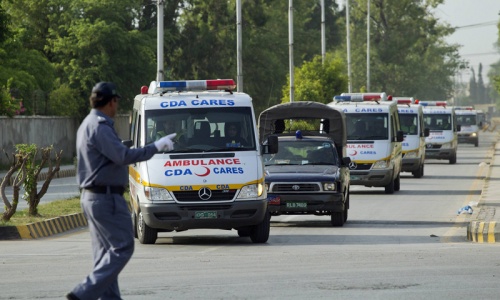ISLAMABAD: Police in Gilgit-Baltistan said Thursday they have arrested 18 suspects over the killing of 10 foreign climbers in the Himalayas in June, but warned that others remain at large.
The June 22 attack was the deadliest assault on foreigners in Pakistan for a decade and was claimed by a purported new faction of Pakistan’s umbrella Taliban movement, the Tehrik-i-Taliban Pakistan (TTP).
Police in the northern districts of Gilgit and Diamer in the Gilgit-Baltistan region said they have arrested 18 suspects on suspicion of planning and carrying out the attack.
The officer leading the investigation said only four of those held are believed to have been directly involved in the killings at the foot of Pakistan’s second highest mountain Nanga Parbat.
“We have arrested four culprits who shot the tourists at Nanga Parbat base camp while seven are still at large,” Muhammad Naveed told AFP.
The victims of the attack, carried out by men in police uniforms, were identified as one American with dual Chinese citizenship, three Ukrainians, two other Chinese, two Slovakians, one Lithuanian and one Nepalese. A Pakistani guide was also killed.
New details emerge
Further details of the attack have emerged during interrogation. The suspects have revealed that their original plan was to kidnap the trekkers, an investigating officer said.
“They said their plan went foul when one of the Chinese resisted after they approached them,” he said.
“After the Chinese tourist retaliated, one of the terrorists fired a shot that killed him and the terrorists fought with each other over it. After that they sprayed bullets at all the tourists.”
Asked if the kidnap could have worked, the officer said it would have been almost impossible for them to escape with the hostages because of the difficult terrain.
A senior official of the local administration said extremists from Diamer district had linked up with the Pakistani Taliban and travelled to the tribal areas along the Afghan border for training.
A group of 35 including the 18 detainees was trained in North Waziristan.
“This group was launched as an extension of the Pakistani Taliban in the northern region,” the official told AFP, adding that the group had been behind a rise in killings targeting Shia Muslims in the north.
Naveed, the senior police officer, also confirmed that some of the suspects arrested in connection with the Nanga Parbat attack had links with the Pakistani Taliban.
After the attack the Taliban said it had set up a new faction, Junood ul-Hifsa, to kill foreigners to avenge US drone strikes on Taliban and Al-Qaeda operatives in northwest Pakistan.
Until the June 22 attack, Gilgit-Baltistan was considered immune from much of the militancy plaguing other areas.
The killings badly hit the local tourism industry, a major economic prop.












































